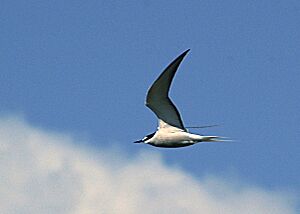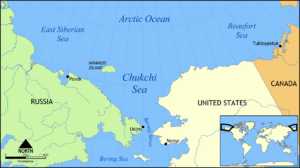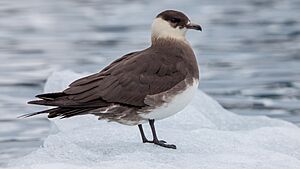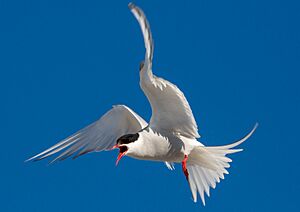Aleutian tern facts for kids
Quick facts for kids Aleutian tern |
|
|---|---|
 |
|
| Conservation status | |
| Scientific classification | |
| Genus: |
Onychoprion
|
| Species: |
aleuticus
|
 |
|
| Aleutian Tern Distribution Breeding Non-breeding | |
| Synonyms | |
|
Sterna aleutica Baird, 1869 |
|
The Aleutian tern (Onychoprion aleutica) is a migratory bird. This means it travels long distances between its breeding and wintering grounds each year. It lives in the subarctic regions of the world for most of the year.
This bird looks a lot like the Arctic tern. Both have a black cap on their heads. However, the Aleutian tern has a white forehead. Young Arctic terns can also have white foreheads. During the breeding season, Arctic terns have bright red bills, feet, and legs. Aleutian terns, though, have black ones.
Scientists haven't studied the Aleutian tern as much as other birds. For a long time, no one knew where they spent the winter. Now, we know many of them fly to the western Pacific Ocean near the Equator. Aleutian terns breed in large groups called colonies. These colonies are found only along the coasts of Alaska and eastern Siberia. Sadly, the number of Aleutian terns in both Alaska and Siberia seems to be going down.
Contents
What is the Aleutian Tern?
The Aleutian tern, Onychoprion aleutica, is a type of seabird. It belongs to the Laridae family. This family also includes gulls, other terns, and skimmers. These birds are all part of a larger group called Charadriiformes.
The name Onychoprion comes from ancient Greek words. Onux means "claw" or "nail," and prion means "saw." The word aleuticus refers to the Aleutian Islands. This is where the bird was first discovered.
This bird used to be called Sterna aleutica. Scientists group animals based on how closely they are related. Over time, they learned that Onychoprion terns are different from the "typical" terns in the Sterna group. Even so, Onychoprion and Sterna are still closely related. It has been hard for scientists to figure out how all terns are related. This is because there aren't many fossils of them.
How to Identify an Aleutian Tern
The Aleutian tern is a medium-sized bird. It is about 32–39 centimeters (12.5–15 inches) long. Its wingspan is about 75–80 centimeters (29.5–31.5 inches). It weighs between 84 and 140 grams (2.9–5.0 ounces). It has a short, pointed bill and a long, deeply forked tail.
What Does an Aleutian Tern Look Like?
When adults are breeding, they have a white forehead and a black cap. Their back is mid-grey, and their belly is dark grey. Their rump and tail are white. The underside of their wings is whitish. They have dark tips on their main flight feathers. A special dark bar on their secondary feathers helps identify them. Their bill and legs are black. Males and females look very similar.
We don't know much about what non-breeding adults look like. They are thought to be similar to breeding adults. They have white bellies and a white-speckled crown. Their tail is grey with white sides. The dark bar on their secondary feathers stays even in winter.
Young Aleutian terns have a white collar and a lot of white on their forehead. Their belly is white, and their tail is grey. They usually don't have the clear dark bar on their secondary feathers.
What Does an Aleutian Tern Sound Like?
The Aleutian tern makes several different sounds. Its calls are higher-pitched than those of the Common tern. They sound soft and like a rolling whistle.
One common call is a choppy “chif-chif-chu-ak.” This sound is not as harsh as the Arctic tern's call. Another special sound is a long "whee-hee-hee-hee" with stress on the first part. Aleutian terns also make a short, sharp "chit" sound. They might use this sound when they meet other terns.
When an Aleutian tern is sitting on its eggs, it is usually quiet.
Where Do Aleutian Terns Live?
During the breeding season, Aleutian terns gather in colonies. These colonies are found along the Pacific coasts of Alaska and Russia. You can find them along the Chukchi Sea coast in western Alaska. They also live on the Seward Peninsula, the Yukon-Kuskokwim River Delta, the Alaska Peninsula, and the Aleutian Islands. Other spots include the Kodiak Archipelago, the Kenai Peninsula, and the Copper River delta. They are also found along the Gulf of Alaska.
Scientists estimate there are at least 31,000 Aleutian terns in the world. Most of them (about 25,600) live in Russia. The rest (about 5,500) live in Alaska. However, in the last ten years, many colonies in Alaska have gotten smaller or disappeared.
This bird is a strong migratory traveler. We don't know much about where they spend the winter. But it is thought to be near Indonesia and Malaysia. Small groups have been seen more often near Hong Kong in spring and fall. They are also seen near Singapore and Indonesia from October to April. And they appear in coastal waters of Java, Bali, and Sulawesi in December. Their regular appearance near Hong Kong in the fall suggests a path they might take south.
The Aleutian tern is special because it's the only tern that travels from a subarctic breeding area to warm, tropical winter areas in the South Pacific every year. Only a few birds that breed in Alaska travel to East Asia.
Where Do They Like to Live?
Aleutian terns usually live on sandy beaches with some plants. They also like grassy meadows, mossy boglands, and marshes. They can be found on isolated rocky islands or along coasts, often near river mouths. When they are not breeding, they live in the open ocean, far from land.
What is Their Status?
The number of Aleutian terns is going down quickly. In Alaska, their numbers have dropped by about 8.1% each year since 1960. This means a huge drop of 92.9% over three generations. Larger colonies are shrinking more than smaller ones. Because of this, the Aleutian tern is now listed as a “Vulnerable” species.
We don't know exactly why their numbers are declining. But it might be because their habitat is changing. Other reasons could be predation (being hunted), people collecting their eggs, and human disturbance. Also, their wintering areas in Southeast Asia might be causing problems. This region has issues like too much fishing, building along the coast, and pollution. Aleutian terns are very sensitive to being disturbed at their colonies. They might leave their nesting sites for a season or even forever if people bother them.
How Are They Being Protected?
Many groups are worried about the Aleutian tern. These include the Alaska Department of Fish and Game, Audubon Alaska, and the U.S. Fish and Wildlife Service. In 2007, a group called the Aleutian Tern Working Group started in Alaska. They wanted to find better ways to count the birds. This would help them plan how to protect the species and find out where they migrate. In 2010, they started putting small tracking devices called geolocators on Aleutian terns in Alaska.
We need more information about how they breed and what they do in nature. This will help scientists create better plans to protect them. Future research should focus on watching their populations and colonies in Alaska, Russia, and the South Pacific. It's also important to understand why their numbers have been dropping recently.
How Do Aleutian Terns Behave?
Breeding and Raising Young
Aleutian terns breed in colonies. They usually return to the same nesting spot each year if it's safe. Pairs form when they arrive at the breeding area. They build their nests in late May and early June, just before laying eggs. A typical nest has two eggs, but sometimes it's one or three.
The nest is a shallow dip in the ground. It's often built among low plants like mosses, lichens, or grasses. Both parents sit on the eggs and feed the chicks. However, the female spends more time on the nest. The male does more fishing to bring food. Aleutian terns spend less time keeping their chicks warm than Arctic terns do. Because of this, more Aleutian tern chicks die.
Their eggs are usually oval-shaped, about 40–46 millimeters long. They can be clay-green or honey-yellow. They are often darker than other tern eggs. They have distinct large and small black spots. The eggs hatch from early June to late July, after about three weeks. A few days after hatching, the young birds move to taller plants. Then they move with the adults to gathering areas along the coast. After 4–5 weeks, the chicks learn to fly.
Aleutian terns are easily scared away from their nests. If something bothers them, the adults fly off. They take a long time to return to their nests, sometimes up to 30 minutes. This is much slower than Arctic terns. Aleutian terns sometimes nest near Arctic terns. Arctic terns are very protective of their nests and young. They will attack large predators. But Aleutian terns are not as aggressive in defending their nests or young.
Courtship and Mating
Scientists haven't fully described how Aleutian terns find a mate. But most terns show similar behaviors. These include special "fish flights," "low flights," "high flights," and ground "parades."
Before mating, several terns might fly together in a spiral. This happens in May, before courtship begins in early June. Pairs don't always mate at the colony itself. Some have been seen courting on nearby beaches.
What Do They Eat and How Do They Find Food?
Aleutian terns mainly eat small fish. But they also eat crustaceans, insects, and tiny ocean creatures called zooplankton. They find food mostly by flying. They hover low over the water and then swoop down. Or they dip into the water's surface to grab their food. They only seem to catch food from the surface. They don't dive deep into the water like some other birds. Terns are not good swimmers because they have small webbed feet and short legs.
Aleutian terns usually look for food in shallow water. This includes areas with strong tides, along rivers, and in coastal ocean waters. Sometimes, adults and young birds catch insects in the air over freshwater ponds. They can fly far out into the ocean to find food. They might fly up to 11 kilometers (7 miles) offshore from the Seward Peninsula. From other colonies, they might fly up to 50 kilometers (31 miles) offshore. Sometimes, one tern will try to steal fish from another tern bringing food to its chicks. Aleutian terns are excellent flyers and can catch insects while flying.
How Do They Fly?
Aleutian terns fly very gracefully. Their flight is strong and steady. Their wings beat slower than those of Arctic and Common terns. They mostly fly over the ocean, not over land. Like other terns, they walk quite slowly because of their short legs.
How Do They Interact with Each Other?
Aleutian terns are very social birds. Their nests are usually found in loose colonies with other bird species. It's rare to find colonies with only Aleutian terns or just single pairs. Colony sizes usually range from 4 to 150 pairs. But on Sakhalin Island in Siberia, there can be up to 700 pairs.
Aleutian terns often nest with Arctic Terns in Alaska. In Siberia, they often nest with Common Terns. Sometimes, colonies of Mew Gulls are also close to Aleutian tern nests.
Aleutian terns are not as aggressive as Arctic Terns. Arctic Terns often chase Aleutian terns at colonies. They can also keep Aleutian terns away from good feeding spots. Arctic Terns might even steal food from Aleutian terns.
Who Hunts Aleutian Terns?
The eggs and chicks of Aleutian terns are hunted by many different animals. Here is a list of some of their predators:
- Arctic fox (Vulpes lagopus)
- Coyote (Canis latrans)
- Dogs (Canis familiaris)
- River otters (Lutra canadensis)
- Weasels (Mustela spp.)
- Brown bears (Ursus arctos)
- Norway rats (Rattus norvegicus)
- Bald Eagles (Haliaeetus leucocephalus)
- Parasitic Jaegers (Stercorarius parasiticus)
- Glaucous-winged Gulls (Larus glaucescens)
- Short-eared Owls (Asio flammeus)
- Black-billed Magpies (Pica pica)
- Northwestern Crows (Corvus caurinus)
- Common Ravens (Corvus corax)
If humans disturb Aleutian terns, they often fly high above the colony. They can chase away birds that try to hunt them. But they are not as aggressive as Arctic terns. Sometimes, Arctic terns even kill Aleutian tern chicks. However, Aleutian terns often do better when Arctic terns are around. This is because Arctic terns are very aggressive and help chase away predators from the colony.
|
See also
 In Spanish: Charrán aleutiano para niños
In Spanish: Charrán aleutiano para niños






